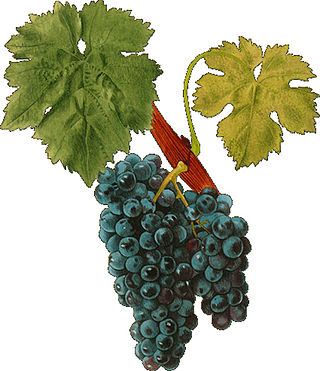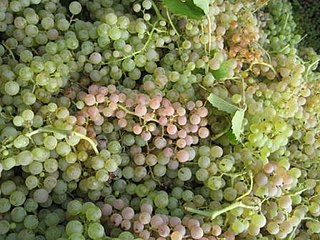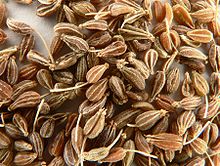
Carignan is a red grape variety of Spanish origin that is more commonly found in French wine but is widely planted throughout the western Mediterranean and around the globe. Along with Aramon, it was considered one of the main grapes responsible for France's wine lake and was a substantial producer in jug wine production in California's Central Valley but in recent years, it has been reborn as a flagship wine for many cellars in the south of France as well as in Catalonia.

Garganega is a variety of white Italian wine grape widely grown in the Veneto region of North East Italy, particularly in the provinces of Verona and Vicenza. It is Italy's 6th most widely planted white grape. It forms the basis of Venetian white wine Soave and is also a major portion of the blend used to make Gambellara.

Nerello is a name given to two varieties of red wine grapes that are grown primarily in Sicily and Sardinia.
Greco is an Italian wine grape that may be of Greek origin. The name relates to both white (Greco bianco) and black (Greco nero) grape varieties. While there is more land area dedicated to Greco nero, the Greco bianco is the grape most commonly referred to by "Greco". In the Campania region it is used to produce the Denominazione di Origine Controllata e Garantita (DOCG) wine Greco di Tufo. In Calabria, it is used to make the Denominazione di Origine Controllata (DOC) wine Greco di Bianco. The name "Greco" is sometimes used as a synonym for several varieties of supposed Greek origins-most notably Trebbiano.

Fiano is a white Italian wine grape variety that is grown primarily in the Campania region of southern Italy and on the island of Sicily. In Campania, this fairly strong flavored white wine grape is particularly noted around Avellino where the Denominazione di origine controllata e Garantita (DOCG) wine of Fiano di Avellino is produced. The grape has a long history in the Campanian region and is believed to have been the grape behind the ancient Roman wine Apianum. Even today, the name Apianum is permitted to appear on wine labels of the DOCG wine Fiano di Avellino.

Arneis is a white Italian wine grape variety originating from Piedmont, Italy. It is most commonly found in the hills of the Roero, northwest of Alba, where it is part of the white Denominazione di Origine Controllata e Garantita (DOCG) wines of Roero. It can also be used to produce DOC wines in Langhe. Arneis is so called because it is regarded as a somewhat difficult variety to grow. It is a crisp and floral varietal, and has been grown for centuries in the region. The white wines made from the Arneis grape tend to be dry and full bodied with notes of pears and apricots.

Moscato Giallo or Yellow Muscat is a white Italian wine grape variety that is a member of the Muscat family of grapes. Known for its large deep cluster of loose, deep-yellow berries and golden colored wine, Moscato Giallo is grown mostly in northern Italy where it is most often used to produce passito style dessert wines. The grape is also planted in Croatia where it is known as Muškat žuti.

Bombino bianco is a white Italian wine grape variety planted primarily along Italy's Adriatic coast line, most notably in Apulia. The vine is prone to high yields and often produces neutral flavor wines. The grape is known under many synonyms throughout Italy including Debit and Pagadebit, names which came from the grape's reputation for being a high yielding and reliable crop for vineyard owners to grow that would assure them that on each vintage they could pay off their debts.

Catarratto is a white Italian wine grape planted primarily in Sicily where it is the most widely planted grape. Catarratto can make full bodied wines with lemon notes. In the Etna DOC, the grape is often blended with Minella bianca and Carricante.
Bombino nero is a red Italian wine grape variety that is grown in southern Italy, particularly the regions of Apulia, Basilicata, and Lazio, as well as on the island of Sardinia. It is a permitted grape variety in the Denominazione di origine controllata (DOC) wines of Castel del Monte and Lizzano. The grape is primarily a blending grape but it can also be used as a varietal for red and rosé wines. Though DNA evidence has shown that Bombino nero is not a dark-berried color mutation of the similarly named Bombino bianco, ampelographers still believe that the two varieties are related in some way.

Albarola is a white Italian wine grape variety grown in the northwest Italy. It is most commonly found in the Liguria region where producers in the Cinqueterre Denominazione di origine controllata (DOC) use it as a blending component. Wine expert Jancis Robinson describes the wine made from Albarola as fairly "neutral" in profile. Outside of Liguria, the grape was historically grown in Sicily but for most of the 20th century has been declining in plantings along with other ancient Sicilian varieties like Albanello, Damaschino, Minella bianca and Montonico bianco.
Etna is a Denominazione di origine controllata (DOC) for wine from the Etna region in Italy.

Nosiola is a white Italian wine grape variety that is grown in the Trentino region north of Lake Garda in the Valle dei Laghi. Here it is used in varietal Denominazione di origine controllata (DOC) wines and as a blending component in wines such as Sorni Bianco from Trento. It is also used to produce a dessert wine in the Vin Santo style from grapes that have been allowed to dry out prior to fermentation.
Albanello bianco is a white Italian wine grape variety grown primarily in Sicily where it has a long tradition producing sweet dessert-style wines from grapes that have been dried in the sun on mats for several days after harvest. In the eighteenth century, the grape was an important component in the rare and expensive Marsala-style wine Ambrato di Comiso.
Catanese nero is a red Italian wine grape variety that is predominantly grown in Sicily. While ampelographers believe that grape likely originated in the shadow of Mount Etna in province of Catania on the east coast of the island, today it is mostly grown in the northwestern provinces of Agrigento, Palermo and Trapani. A minor blending variety used in rosé production, the grape is not currently permitted for use in any Denominazione di origine controllata classified wines.
Mantonico bianco is a white Italian wine grape variety grown in the Calabria wine region of southern Italy. The grape should not be confused with the similarly named Calabrian grape Montonico bianco or with Guardavalle, which is known as Mantonico in the province of Cosenza in Calabria. In the early 21st century, DNA profiling suggested that Mantonico bianco may be one of the parent varieties of the red Calabrian grape Gaglioppo which is also known as Mantonico nero.
Verdello is a white Italian wine grape variety that is grown mostly in the Umbria region of central Italy where it plays a minor role as a blending grape in several Denominazione di Origine Controllata (DOC) wines, including Orvieto. Despite similarities in their names, the Italian Verdello grape has no close genetic relationship with the Portuguese wine grape Verdelho that is grown on the islands of Madeira and Azores. However, like the Portuguese grape, Verdello's name likely comes from the dark green color of its berries before veraison.
Barbera del Sannio is a red Italian wine grape variety that is grown in the Campania region of southern Italy. Despite the similarities in name and appearance, the grape has no close genetic relationship with the Piedmont wine grapes Barbera or Barbera bianca or the Sardinian wine grape Barbera Sarda and is, instead, more closely related to the Campanian varieties Casavecchia and Catalanesca and the Apulian grape Nero di Troia.
Bianchetta Trevigiana is a white Italian wine grape variety that is grown in the Trentino-Alto Adige/Südtirol and Veneto wine regions of northeast Italy. Here the grape is rarely used a varietal but, instead, is a permitted blending grape adding acidity to the wines of several Denominazione di Origine Controllata (DOC) zones including the sparkling wine Prosecco and has also been used for vermouth production. The name Trevigiana is derived from the province of Treviso where the grape is believed to have originated from.
Carricante is a white wine indigenous to Sicily, Italy. This late-ripening vine is the main variety used in the Etna DOC. It is usually found blended with Catarratto and Minella bianca. As a varietal wine, Carricante produces a fresh, straw-yellow, lightly fragrant white wine. The name Carricante comes from the Italian caricare, in reference to the variety's heavy yields. It is not related to the variety Nocera, which is sometimes called Carricante nero. Carricante is grown at high altitudes on Mount Etna relative to other grapes, growing at around 950 meters above sea level on the eastern slopes and at 1,050 meters on the southern slopes. Wines made from it tend to be high in total acidity with a low pH and have traditionally been subject to malolactic fermentation.












